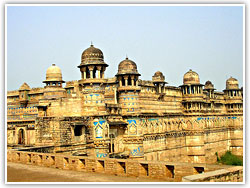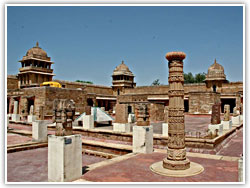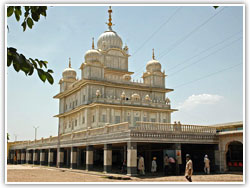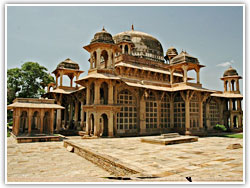|
|
Gwalior Attractions
.............................................................................................................................................................................. |
|
Tourist
Attractions in Gwalior
The main tourist attraction in Gwalior is the Gwalior
Fort and Teli-ka Mandir and Sas Bahu Mandir. The other
tourist attractions in Gwalior are Man Mandir Palace and
Vikramaditya Palace. |
|
|
Gwalior Fort
The Gwalior Fort, situated on the top of the hill
dominates the Gwalior city. The fort is situated
on a high sandstone precipice about 91 m above the
surrounding plain and is 2.8 km long and 200-850 m
wide. In some places the cliff overhangs, in other
it has been scarped to make it unscalable. The
main entrance to the north comprised of a
twisting, easily defended approach and the seven
gates. These gates are Alamgiri, Hindola, Bhairon,
Ganesh, Lakshman, Hathiapur and |
 |
|
|
Hawa.
Out of these seven gates only five remains. The walls
are 9 m high and when seen from the north present a
formidable battlement. On the west is the Urwahi gorge
and another well-guarded entrance. There are many tanks
on the plateau and the Gwalior fort is one of the most
impregnable fortress of north and central India. The
first Mughal Emperor Babur also described the fort as
the pearl amongst fortresses of Hind. There are 21 Jain
sculptures that belong from the 7th to 15th centuries
and of various sizes up to 20 m tall on the Urwahi Gate.
Babur was offended by them and ordered their faces and
private parts to be destroyed. But, now their faces have
been repaired. Suraj Kund, where the Suraj Sen’s leprosy
was cured by the saint Gwalipa is also situated inside
the fort. It is a large tank and reservoir.
Teli-ka Mandir and Sas Bahu Mandir
The unique Teli-ka Mandir is about 30 m high and a
Pratihara Vishnu Temple. This temple dates back to the
9th century AD and blends a number of regional styles.
This temple has an interesting design, and the shape of
the roof is in Dravidian style while the rest of the
temple is covered with Indo-Aryan sculptures. A Garuda
crowns the doorway. The Sas Bahu Mandir (Mother-in-law,
Daughter-in-law temple) is also dedicated to Vishnu.
This temple belongs to the 11th century. The larger of
the two has an ornately carved base and four heavy
pillar support the roof.
Vikramaditya Palace
The Vikramaditya Palace is located between the Man and
Karan Palace. This place was built in 1516 and connected
with the two palaces by narrow galleries. Inside the
palace is an open hall with a domed roof. In the
northern side and opposite the Dhonda Gate is the Karan
Mandir, a long double storeyed building with one large
room and a roof supported on two rows of pillars. To the
south is a hall with a Hindu dome room. |
|
|
|
Gujari Mahal
Within the fort are some marvels of medieval
architecture. The 15th century Gujari Mahal is a
monument to the love of Raja Mansingh Tomar for
his Gujar queen, Mrignayani. After he had wooed
and won her, so the story goes, Mrignayani
demanded that he build her a separate palace with
a constant water supply from the River Rai, via an
aqueduct. The outer structure of the Gujari Mahal
has survived in an almost total state of
preservation; the interior has been converted into
an |
 |
|
|
Archaeological Museum.
Man Mandir Palace
The Man Mandir Palace was built by Raja Man Singh
between 1486 and 1517. The exterior of the palace is
built of red sandstone and decorated with blue tiles,
elephants, yellow ducks and peacocks. The palace is
richly ornamented and architecturally interesting. This
palace also won the admiration of Akbar. The walls are
massive and elegant, and possess towers and atractive
lattice work battlements. It is two storeys high with a
further two underground floors complete with an
ingenious ventilation system. In these under chambers,
prisoners were tortured and killed and they were also
used as a refuge when the fort was under attack. The
upper rooms are arranged round two courts and are small
and beautifully executed. Many of the smaller rooms off
the main court were used as bedrooms. The multiple iron
rings in the ceiling were used for swinging cots and
hanging screens.
Lashkar
Lashkar means army camp which Maratha chief Daulat Rao
Scindia had set up in 1809 to take control of Gwalior,
to the south of the fort. The town later came to be
known as Lashkar. The Jai Vilas Palace, King George Park
and the chattris (memorial tombs) of the Maharajas are
found in Lashkar. Jai Vilas Palace was designed by Lt.
Col. Sir Michael Filose and was built in early part of
the 19th century by the family of the Maharaja Scindia.
This palace was completed in three years for the
Maharaja Jayaji Rao who built it on borrowed English
money. It is an enormous place, built in an Italian
palazzo style. In the Durbar Hall, which is approached
by a crystal staircase, hang the two largest chandeliers
in the world. There is the largest carpet in Asia, an
electrically-lit rock garden, and a silver electric
train set which transported cigars and port round the
dinner table. Half of the palace is still the residence
of the current Maharaja, while the other part has been
converted as a museum. The Muhammad Ghaus Tomb and the
Tansen Tomb are also situated in this area. The Muhammad
Ghaus Tomb is built in the form of a square with a
hexagonal tower. The corners are surmounted by small
domes, the interior of the building is enclosed on all
sides by carved stone lattice screens. The Tansen Tomb
is situated near the Muhammad Ghaus Tomb. Tansen was a
famous musician who lived in Akbar’s time and was one of
the emperor’s Nine Jewels of the Court. |
|
|
|
Gurudwara Data
Bandhi Chhod
built in the memory of Guru Hargobind Sahib, the
6th Sikh Guru who was imprisoned here by Jehangir
for over two years. At the time of his release, he
wanted 52 Hindu kings who were his fellow
prisoners, released with him. Jehangir was very
impressed with the Guru and agreed to his
condition. And, finally, within the Fort complex,
housed in the erstwhile barracks of the British
soldiers, is Gwalior's unique gift to modern India
: Scindia School. Acknowledged as one of the
finest |
 |
|
|
schools
in India, it is only fitting that the country's young
citizens receive the best educational grounding
surrounded by monuments to a past which is a constant
inspiration.
Jai Vilas Palace
A splendour of a different kind exists in the Jai Vilas
Palace, current residence of the Scindia family. Some 35
rooms have been made into the Scindia Museum, and in
these rooms, so evocative of a regal lifestyle, the past
comes alive. Jai Vilas is an Italianate structure which
combines the Tuscan and Corinthian architectural modes.
The imposing Darbar Hall has two central chandeliers,
weighing a couple of tonnes, and hung only after ten
elephants had tested the strength of the roof. Ceilings
picked out in gilt, heavy draperies and tapestries, fine
Persian carpets, and antique furniture from France and
Italy are features of these spacious rooms. Eyecatching
treasures include : a silver train with cut-glass wagons
which served guests as it chugged around on miniature
rails on the tables; a glass cradle from Italy used for
the baby Krishna each Janamashtami; silver dinner
services and swords that were once worn by Aurangzeb and
Shah Jehan. There are, besides, personal momentoes of
the past members of the Scindia family: the jewelled
slippers that belonged to Chinkoo Rani, four-poster
beds, gifts from practically every country in the world,
hunting trophies and portraits. The Scindia Museum
offers an unparalleled glimpse into the rich culture and
lifestyle of princely India.
Monuments
Tansen's Tomb
The father of Hindustani classical music, the great
Tansen, one of the 'nine Jewels' of Akbar's court, lies
buried in Gwalior. The memorial to this great musician
has a pristine simplicity about it, and is built in the
early Mughal architectural style. More than a monument,
the Tansen's Tomb is part of Gwalior's living cultural
heritage; it is the venue of a music festival on a
national scale held annually in November-December.
Leading musicians of the country gather here to give
performances during the festival. |
|
|
|
Ghous Mohammed's
Tomb
the sandstone mausoleum of the Afghan prince,
Ghous Mohammed, also designed on early Mughal
lines. Particularly, exquisite are the screens
which use the pierced stone technique, as delicate
as lace.
Memorials
The earliest freedom fighters, Tatya Tope and the
indomitable Rani of Jhansi, are commemorated in
memorials in Gwalior. There are cenotaphs at major
public |
 |
|
|
crossings, memorials to Scindia kings and queens.
Throughout the city, there are these reminders of a
proud past, of the great men and women of Gwalior who
have their place in the nation's roll of honour.
Art Galleries and Museums
The Gujari Mahal Archaeological Museum houses rare
antiquities, some of them dating back to the 1st century
AD. Even though many of these have been defaced by the
iconoclastic Mughals, their perfection of form has
survived the ravages of time. Particularly worth seeing
is the statue of Shalbhanjika from Gyraspur, the tree
goddess, epitome of perfection in miniature. The statue
is kept in the custody of the museum's curator, and can
be seen on request. The museum is open every day except
Monday, from 10 am to 5 pm.
The Kala Vithika is another treasure house of the arts.
It remains closed on Sunday and public holidays. The
Municipal Corporation Museum, which is open all days
except Mondays, has a very fine natural history section.
The old ancestral house of the legendry Ustad Hafiz Ali
Khan has recently been converted into 'Sarod Ghar' -
Museum of Music by the Ustad Hafiz Ali Khan Memorial
Trust under the patronage and guidance of his great son
and sarod maestro Ustad Amzad Ali Khan. The museum has
been rebuilt keeping in mind the old traditional
architecture of Gwalior and houses in it ancient
instruments of the great Indian Masters of yesteryears.
Excursion from Gwalior
Shivpuri
The old summer capital of Shivpuri is situated about 117
km. south-west of Gwalior. The road to Shivpuri passes
through the Shivpuri National Park. Shivpuri is also
known for the Shivpuri National Park. Shivpuri was the
summer capital of the Scindia Rulers and now a famous
game reserve. The dense forests of the Shivpuri National
Park consists of dry deciduous forest of dhok and were
the hunting grounds for tigers and elephants of the
Mughal Emperor Akbar. Its main mammals include nilgai,
chinkara, chowsingha, sambar, cheetal and wild pig.
There is also a large perennial lake. The lake attracts
numerous waterbirds including migratory ducks and
bar-headed geese which stay on until May. On its shores,
you can see huge flocks of demoiselle cranes. The best
months to visit Shivpuri National Park are from January
to March. In Shivpuri there are also various tombs of
the Scindia rulers. These tombs are set in formal Mughal
style gardens with quiet nooks under flowering trees,
interecting pathways and lit by ornamental Victorial
lamps. Architecturally, they are a synthesis of Hindu
and Islamic style with their Shikhara-type spires and
Mughal pavilions. Near Shivpuri, there is a pleasant
lake with gardens around its perimeter.
Narwar
Narwar is the beautiful old capital of Gwalior state and
has been made famous recently by India Tourism
Development Corporation by setting up tented
accommodation at this beautiful place. Narwar also has a
very large and old fort.
Datia
Datia is situated about 69 km from Gwalior. The Bundela
chief, Bir Singh Deo was responsible for the fortress
palace at Datia. Till the 1930, Datia was always on the
standard itineraries of the British Viceroys. In 1902,
Datia hosted Lord Curzon. The hill-top Gobind Palace is
the famous palace at Datia. This seven-storey palace
awed even the British architect Lutyens who was never an
admirer of Indian architecture. He described this palace
as one of the most interesting buildings architecturally
in the whole of India. The palace is a fabulous maze of
latticed corridors, verandahs, pillared cupolas and
rooms with frescoes. Once these rooms were studded with
semi-precious gems. The palace is surrounded by a 17th
century stone wall.
Sonagiri
Sonagiri, the sacred Jain hill lies 3 km to the North
West of Datia and is 5 km from the railway station.
There are 77 Jain temples, built in rows on the hill and
its slopes, and date back to the 17th century. Of these
the temple dedicated to Chandranatha, the 8th of the 24
Tirthankaras, is quite a large one and the most
beautiful. A large annual fair is held here in the month
of Chaitra (April).
Pawaya
Pawaya, also known as Padmavati in ancient times is a
fascinating complex of ruins, 68 km away, on the
Gwalior-Jhansi road. Pawaya's ruins still bear testimony
to the days when it was the capital of the Nag Kings, in
3 AD. Particularly noteworthy is the lifesize statue of
Chaksha Manibhadra of 1 AD. The ruins of the medieval
fort built by the Parmars and the nearby Dhoomeshwar
Mahadeo temple are Pawaya's other attractions. |
|